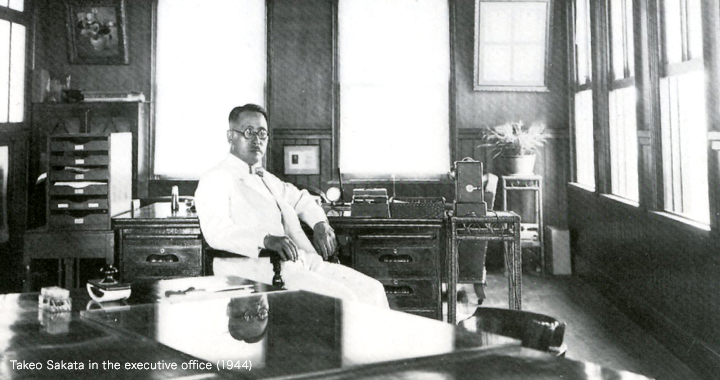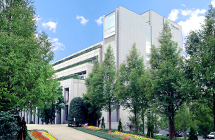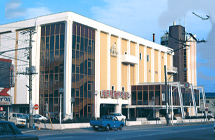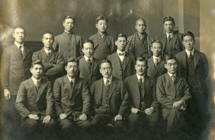
History 02
Pioneering Days
From Overcoming Growing Pains to Success with the World's First F1 All-Double Petunia
The World's First F1 All-Double Petunia Takes Silver at the AAS
Takeo Sakata was contracted by a leading international seed company to grow seeds and he continued to actively participate in the breeding selection process to improve cultivars – including South American petunias – while still growing seeds and selling them to the Japanese market. In response to a request from Dr. Hiroshi Terao of the National Agricultural Experiment Station, he also imported double flower petunias from overseas companies.
These petunias were used by a researcher named Woo Jangchun, who discovered that double flower petunias were genetically dominant to single flower varieties. Confident that success would be guaranteed if a petunia could be developed that would yield only double flowers, Takeo devoted himself to all-double flower petunia breeding and seed production.

Woo Jangchun

All-Double Petunia "Victorious Mixed"
After several years of trials, not only had Sakata achieved outstanding success by developing F1 petunia seeds that yielded only double flowers, but also 80% of the blooms featured beautiful, wave-like petals, resembling the designs on the handball used in the traditional Japanese game "Temari". The other 20% were carnation-type blooms. Within a few short years, people were commending this "Sakata magic" and orders for this all-double flower petunia were flooding in from seed companies worldwide.
As there was a monopoly on the product, it was traded at high prices. According to the Chicago Herald Examiner (June 20, 1935), Sakata's all-double flower petunia seeds were sold at $10,565 per pound (454 g), about 20 times the value of their weight in gold, which speaks volumes about how greatly these tiny seeds – which are smaller than poppy seeds – were valued.
In 1934, the All Double Petunia "Victorious Mix" won silver medal at the prestigious All America Selections (AAS), and from then up until the start of the Pacific War in 1941, new varieties of petunias from Sakata would go on to win eight silver or bronze medals.

The price of All-Double Petunia published in "Chicago Herald Examiner" (June 20, 1935)

All-Double Petunia "Victorious Mixed"
silver prize award
Takeo Resigns as President of a Newly Merged Seed Company following the Destruction of the Company's Buildings in a Yokohama Air Raid
After the Manchurian Incident in 1931, immigrants from Japan began to arrive in China in large numbers. Exports from Japan of vegetables, grains, and pasture grass seeds significantly increased with the development of this new market. In 1936, Sakata Shokai established the "Ofuna Farm" to focus mainly on vegetable breeding techniques. However, the second Sino-Japanese War broke out and seed exports began to come under pressure from the government.
Throughout these trying times, Sakata Shokai remained committed to its original mission of developing unique and high-quality products. The result of this perseverance was the world's first F1 cabbage, "Suteki Kanran".
In line with the nationalist policies introduced in January 1942, which encouraged the merging of seed companies, in December Sakata Shokai was dissolved and merged with four other seed companies to form Sakata Seed Corporation, with Takeo appointed as the President.

Ofuna Farm

"Suteki Kanran" published in Sakata seed catalogue in 1940.

Sakata Seed Corporation(1942)
On May 29, 1945, a major fire broke out as a result of the Great Yokohama Air Raid, and the company buildings were destroyed. Takeo, who was 56 years of age at the time, resigned and left everything in the hands of Imasuke Aso, while Sakata and his family evacuated to their cottage on Lake Yamanaka.
On August 15, 1945, the war ended with Japan's defeat. Sakata Seed Corporation, which once employed 170 people, had only 20 working for them at the time. The company's misfortunes continued after the end of the war as "Ofuna Farm" was expropriated as part of post-war government reforms.
Imasuke Aso, the new president, managed to guide the company through the post-war chaos but in the early summer of 1947, he visited Takeo and asked him to return. After a few hours of heated discussion, Takeo yielded to Aso's request and once more became president. He was 58 years of age at the time.

Sakata Takeo in the executive office (1944)

Imasuke Aso
Revival of the Seed Business through Mail Order and Storefront Sales

First issue of "Engei Tsushin"
In April 1948, Sakata Seed Corporation leased a plot of land in the Kanagawa-ward of Yokohama and built the company's new headquarters. As the company's ranks swelled with more and more talented young people engaged in improving breeding techniques and creating outstanding new F1 varieties (hybrids), the company's performance gradually improved.
The Flower Seed Division, which initially engaged in seed and bulb sales for commercial growers, went on to sell horticultural supplies, bulbs, and packets of seeds to nurseries and gardening centers. Comprehensive catalogs were published and sent out and the company started receiving mail orders. The Flower Seed Division contracted out bulb and sapling production in order to deliver the highest possible quality to customers.
In the 1950s, the Retail Division was set up, which resumed its proud pre-war tradition of mail order sales and started storefront sales. Mail order sales were particularly important and "Sono no Izumi" was given a facelift and launched as the monthly magazine "Engei Tsushin" ("Gardening News"), which contained articles aimed at increasing the number of gardening enthusiasts after the war. On December 1, 1951, the company opened a store on the 1st floor of the headquarters building as a gardening center, which up to that point had been somewhat rare in Japan.
Around 1955, the first seed storage facility was completed and a laboratory was established on the first floor of the headquarters building adjacent to the entrance. Here, Sakata Seed Corporation, ahead of other companies, carried out physiological research on seeds and developed materials for use in the seed packets used for exporting seeds. We made prototypes and carried out repeated tests of sealing properties based on foreign packet designs in order to produce our packets that would maintain seeds in the best possible condition. The rate of germination was also indicated on the seed packets to help earn the trust of our customers.













